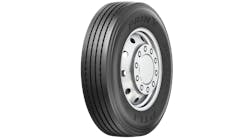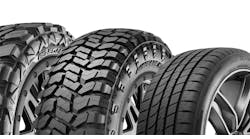Like many businesses, Bridgestone Corp. and its Bridgestone Americas Inc. subsidiary have been “under pressure” due to the economic fall-out from COVID-19, says T.J. Higgins, global chief business strategic officer, Bridgestone Corp. “But we’re starting to see glimmers of hope.”
A reboot of vehicle production is one of them.
Bridgestone Americas’ North American consumer tire plants are scheduled to reopen in May – just in time to start building tires for OEMs.
“We’re seeing manufacturers – particularly (vehicle) OEMs – are planning to come back to production sometime in May,” says Higgins, who also serves as global chief digital strategic officer for Bridgestone Corp.
“It appears that the United Autoworkers and auto manufacturers in the U.S. have come to an agreement on when they want to restart. We’re making sure we are working with our OEM partners to understand when they’re going to start up, what products they will be making and how we can make sure that are plants are ready to support them, as they return to service.
“We feel that May is a good timeframe to reopen,” he explains.
Some plants, he adds, will open sooner than others. “We’re working with local governments to make sure we are supporting their objectives and are bringing plants back up in conjunction with all the rules and regulations of the localities that we work in.”
The shutdown of passenger vehicle production had “significant impact,” he says. Some truck OEMs have curtailed production, too.
“OE has certainly been one of the most challenging” segments of Bridgestone’s overall business, he says.
Quick ramp-up expected
Demand for replacement truck tires in North America “has been ok,” according to Higgins.
“It’s down, but not as down as what we’ve seen in other segments. Our fleet customers are looking at their total supply chain and are making sure they can keep those critically important vehicles moving.”
The company reopened its commercial truck tire plants in Warren County and LaVergne, Tenn., the week of April 13. Combined, those plants have the capacity to produce 15,200 medium truck tires per day at full throttle, according to MTD research.
Bridgestone also opened its farm and OTR tire plants in the U.S. at the same time.
Replacement tire demand has been less robust due to a drop in miles driven by vehicle owners who are under shelter-in-place orders.
“We track online services like Google Maps, which give us information about miles traveled – and not surprisingly, miles are down significantly.”
But that won’t always be the case, he adds.
“We’re carefully watching regionally and even locally to understand the trends as communities reopen. And we’ll be able to communicate these indicators to our (dealer) partners. We’ll share what we are seeing – making sure we have the right tires in the right places at the right times because that’s what our consumers and our dealers need.”
Higgins says Bridgestone’s reopened plants will be able to ramp up quickly.
“We do shutdowns over certain holiday periods routinely,” he says. “We have fairly standard way of ramping up a plant and making sure it’s ready to run.”
What makes this wave of restarts different are the new health and safety measures Bridgestone has taken to protect the well-being of plant workers.
“Space redesign is an area we’ve had to think about. How do we create social distancing? We also want to make sure that our teammates know they – and their counterparts – are safe. We do in-depth screening questionnaires to help them think about their health in advance of coming back to work.
“We’re also doing temperature checks,” he continues. “And then, of course, we are complying with all global and local regulations – masks, face covers, whatever restrictions there are. We make sure we comply with those and very often go beyond to help our teammates remain confident and safe as they return to the manufacturing environment.”
Supply continuity
Combined, Bridgestone’s three consumer tire plants in the U.S. and Canada – Wilson City, N.C.; Aiken County, S.C.; and Joliette, Quebec – can produce more than 70,000 units per day at maximum capacity, according to MTD data.
Those plants, like the company’s commercial tire factories, had been offline since the weekend of March 21. (The shutdown also extended to Bridgestone’s Latin American factories.)
Despite this length of time, Higgins says he feels “very good that we are servicing our customers’ needs, whether it’s from the inventory levels we had in advance of the shutdowns or from some choices we made to bring the right products in from our global network.
“Being a global organization, we’ve always used our global supply chain to support our customers,” he notes. “As we were looking at critical items where our inventory levels were lower than we had thought, we looked to supplement – and bring in – the right products from around the world.”
Most of the winter tires that Bridgestone sells in the U.S. are manufactured in Japan, for example. “We had to continue to import those. But it’s a fluid situation.”
'Closer to customers'
Based on information funneled through Bridgestone’s retail network, including tire dealers, Higgins says there has been an “adjustment in the range of 10%” upwards in consumer tire demand versus late-March, when a “significant drop” occurred.
“But that varies widely. We’re hearing from parts of the southwest more positive news and maybe from parts of the northeast, maybe a little less positive news. But it appears that in early to mid-April, as (stimulus) money became available, we started to see consumers come back out and purchase products they needed.”
Bridgestone’s North American dealers have continued “to get closer to their customers,” he says.
“The ratings and reviews for our industry have actually been more positive over these last few weeks than we have seen in years and that’s because of the incredible dedication of our retailers. They are out there doing some incredibly special things for people and that feedback is being shared.
“We’re doing all we can to prepare our dealers for the pent-up demand and all the opportunities that will come their way” after the economy reopens, he notes.
“We’ve deployed 12 new online training courses since this crisis began,” which gives Bridgestone an opportunity to share data “and allow our dealers to be ready to go.”
New ways of buying?
The unique dynamics of the COVID-19 crisis, including stay-at-home edicts, have changed how some consumers are shopping for – and buying – tires, says Higgins.
“We’re seeing more e-commerce activity – certainly more than we’ve seen in the past as a percentage of sales… more online buying and more people scheduling things online. And that makes sense.
“I don’t know if it will sustain in the future but we have to continue to update our capabilities to handle those transactions that customers would like to have. It could be e-commerce. It could be curbside service. It could be reduced-contact transactions. It could be paperless transactions. People are doing everything they can to avoid places where there could be virus transmission.
“But right now, it’s hard to tell what’s going to stick. What’s not going to change is having best-in-class products and solutions that enhance mobility,” he adds. “And what isn’t going to change is our support of all those dealers who support us.”
Bridgestone developed a “COVID-19 playbook” that contains data on trends the company is seeing “and places to look for early signs of recovery. We also have talked with them about the work we’ve done with governments to understand the financial support that might be available to them, as well as banking support that might be available.”
The goal is to “work in a collective way to provide solutions for those who need us. I think that will serve all of us well as we move into that future state that will be different from today, but still incredibly positive.”


